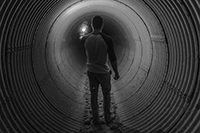 If you revisit some of the lessons learned in basic high school science classes, you will probably remember that 78% of the air we breathe is nitrogen gas. If you think a little more, you may also recall that nitrogen is only safe to breathe when mixed with the right amount of oxygen. That simple lesson, learned so many years ago, may save your life if you frequently work in confined spaces.
If you revisit some of the lessons learned in basic high school science classes, you will probably remember that 78% of the air we breathe is nitrogen gas. If you think a little more, you may also recall that nitrogen is only safe to breathe when mixed with the right amount of oxygen. That simple lesson, learned so many years ago, may save your life if you frequently work in confined spaces.
Before entering any confined work space, there are several critical points you must consider. First, is the work area defined as a confined space according to OSHA? OSHA’s definition states that a confined space is any area where an employee must squeeze in or out through narrow openings and perform their tasks while cramped or contorted. Entry and exit are difficult, and employees are not to remain in the space for lengthy periods of time.
If your work space fits this description, you must also determine if it has a dangerous atmosphere or shows the potential for you to become trapped or even asphyxiated. If so, this space will be designated as a “permit space,” and will require a permit for entry. The employer who allows an employee entry must develop a written safety program for their permit-required spaces.
Your gas monitor plays a crucial part in securing your safety when you are working in a confined space. You need to be certain that you know how to properly operate the instrument and that you fully understand the procedures for confined space monitoring. Taking these steps will lessen the risks associated with this type of work significantly. Do not allow yourself to be lulled into a false sense of security because you are working in a familiar setting. If you take unnecessary risks, you may, unfortunately, only be working in the space for a short time.
Another element of safely working in a confined area is to have an attendant who will maintain contact with you while you are working. Be certain that this person is not involved with any other tasks or distractions and that they remain outside of the confined space at all times. If you will be confined in the space for an extended period of time, this person should record additional atmospheric readings to monitor the safety of the confined space. The attendant should also know exactly what the potential hazards are, and have a plan in place in case of an emergency.
If an emergency situation does arise, the attendant needs to immediately implement the rescue plan that was developed by the employer. No matter what type of rescue situation occurs, the attendant must try to maintain contact with you during the entire rescue process. They should also attempt to gather information about the incident that may be helpful to the rescuers. Their position as “point man” between you and the rescue team can make all the difference in the success of the rescue effort.





